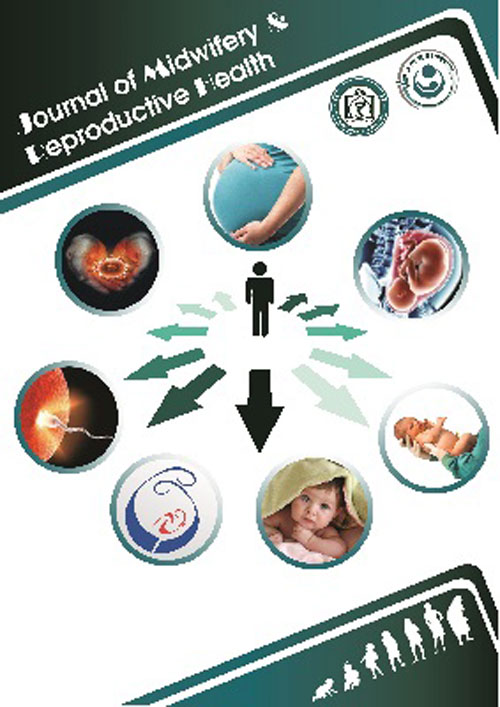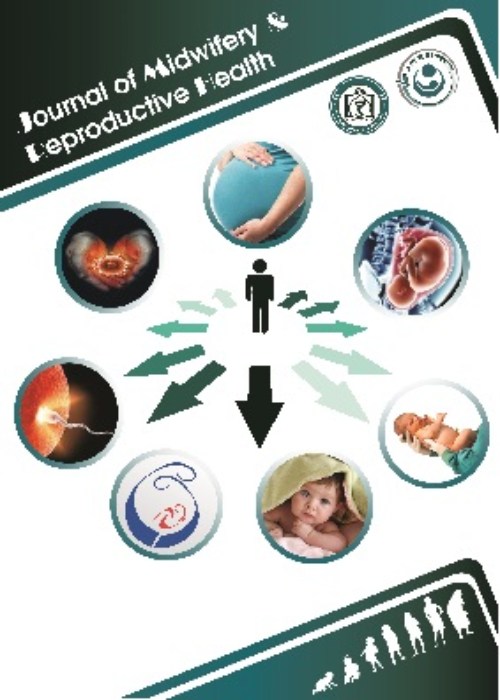فهرست مطالب

Journal of Midwifery & Reproductive health
Volume:3 Issue: 4, Oct 2015
- تاریخ انتشار: 1394/06/20
- تعداد عناوین: 8
-
-
Pages 437-443Background and AimCesarean section (CS) rates have been increasing steadily, worldwide. The knowledge and attitude of health professionals towards natural childbirth and CS are important factors in selecting a mode of delivery. The purpose of this study was to determine the knowledge and attitude of midwifery and nursing students towards different modes of delivery.MethodsIn this descriptive, analytical study, 73 junior students of nursing and midwifery from Isfahan School of Nursing and Midwifery were selected via census sampling. Data were collected using a questionnaire. For statistical analysis, student’s t-test, Mann-Whitney and Pearson’ correlation coefficient were performed, using SPSS version 18.ResultsThe results showed that the 74.20% of midwifery students had a high level of knowledge about natural childbirth and the majority of nursing students had moderate (52.40%) and high (40.5%) levels of knowledge about natural childbirth. Moreover, the 80.60% of midwifery students and 28.6% of nursing students had a high level of knowledge about CS. Also, 97% of midwifery students and 78.6% of nursing students had a positive attitude towards natural childbirth. Moreover the 93.5% of midwifery students had neutral attitude about CS, while 6.5% had a negative attitude towards CS. Also, 5% of nursing students had a positive attitude towards CS, while 95% had neutral attitude about CS.ConclusionThe majority of midwifery and nursing students in answer to questions about attitude towards CS, expressed neutral attitude. Therefore, it is important to discourage positive attitudes towards elective CS while training nursing and midwifery students.Keywords: Attitude, Cesarean Section, Knowledge, Midwifery, Natural Childbirth, Nursing, Students
-
Pages 444-450Background and AimPrimary dysmenorrhea is a common problem among women, resulting in a decline in their performance level and quality of life. Previous studies have not indicated a definite relationship between body mass index (BMI) and dysmenorrhea. Therefore, this study aimed to determine the severity of dysmenorrhea and investigate its relationship with BMI among female adolescents in Hamadan, Iran.MethodsThis cross-sectional study was conducted on 579 single, female adolescents in schools of Hamadan, Iran in 2011. Students with primary dysmenorrhea (without any other conditions) were selected, using random cluster sampling. Demographic characteristics and menstrual cycle information were collected, using two separate questionnaires. BMI was recorded in all participants and visual analogue scale was applied for pain assessment. Chi-square, t-test, Fisher''s exact test and logistic regression were used to examine the relationship between variables. Data were analyzed, using SPSS version 16. P-value less than 0.05 was considered statistically significant.ResultsThe mean age, BMI and age at menarche in participants were 15.94±1.17 years, 21.16±3.36 kg/m2 and 12.92± 1.05 years, respectively. The frequency of dysmenorrhea was estimated to be 85.31%. The frequency and severity of dysmenorrhea was higher in the normal-weight group than other subjects. No relationship was seen between the severity and duration of dysmenorrhea with BMI. But dysmenorrhea had a significant relationship with age at menarche and premenstrual syndrome (P<0.05).ConclusionIn this study, dysmenorrhea was highly prevalent among female adolescents. However, there was no significant association between BMI and dysmenorrhea. We recommend that future studies consider the confounding factors. Also, further research is required to find the relationship between the amount of body fat and dysmenorrhea.Keywords: Body Mass Index, Dysmenorrhea, Female Adolescents
-
Pages 451-455Background and AimOccupational exposures can cause problems such as reproductive system disorders; however, the effects of some exposures, such as psychological stress, have not been investigated yet. This study aims to investigate the effects of women’s psychological stress on obstetric disorders.MethodsThis historical cohort study was conducted on 1400 working women in Mashhad, Iran. Data collection was conducted through completing a check list and a questionnaire on psychological stress and obstetric disorders as well as subsequent interviews with participants on health issues. After completing the questionnaire, the participants were divided into four groups according to their level of psychological stress. Frequencies of reproductive disorders were compared among the four groups. To analyze the data, t-test, ANOVA, Chi-squared and Fisher’s exact tests were carried out using SPSS. P-value less than 0.05 was considered significant.ResultsThe results showed that group four with the most severe psychological stress and the lowest age had the highest risk of reproductive disorders including spontaneous abortion and placental abruption.ConclusionIn this study, severe stress had a significant relationship with the risk of some obstetric complications. It is therefore recommended to use stress management techniques in order to reduce psychological stress, which in turn could prevent its adverse effects.Keywords: Obstetric disorders, Placental abruption, Psychological stress, Spontaneous abortion
-
Pages 456-464Background and AimDuring the postpartum period, women experience physiological changes, which can have negative impacts on their quality of life. Women’s knowledge regarding postpartum complications and care can help them successfully pass this critical period. The aim of this study was to evaluate maternal knowledge on postpartum care in healthcare centers of Mashhad, Iran in 2013.MethodsIn this descriptive, cross-sectional study, 500 eligible mothers were randomly selected via multistage sampling from 19 healthcare centers of Mashhad. Data collection tools included a demographic questionnaire and a researcher-made questionnaire for assessing maternal knowledge. Descriptive and analytical statistics, independent t-test, analysis of variance, Pearson’s correlation coefficient and multivariable regression analysis were applied, using SPSS version 16. P-value less than 0.05 was considered statistically significant.ResultsAmong 500 mothers referring to healthcare centers, 64 (12.8%), 396 (79.2%) and 40 (8.0%) cases had poor, moderate and high levels of knowledge, respectively. The majority of mothers had moderate knowledge about four dimensions of public health, breastfeeding and nutrition, contraceptive methods and infant care. The subjects had the highest and lowest levels of knowledge about public health and contraceptive methods, respectively. The results showed a significant relationship between the mean score of knowledge and demographic characteristics such as educational status, employment status and income level (P<0.05).ConclusionConsidering the moderate level of maternal knowledge about postpartum care, implementation of interventions such as educational workshops and attention to the quality of these courses are essential. Also, particular attention should be paid to the availability and use of educational media for mothers in healthcare centers.Keywords: Knowledge, Mother, Postpartum care, Healthcare center
-
Pages 465-471Background and AimPain and anxiety are the most common complications after cesarean section. The use of medications is the most common strategy for alleviating these problems. However, the adverse effects of these drugs and lack of access to them for some patients, has led to an increase in application of non-drug methods such as massage.MethodsThis blind clinical trial was performed in Omolbanin Hospital of Mashhad, Iran. A total of 80 pregnant women referring to maternity ward for elective cesarean, who had the inclusion criteria were selected through convenience sampling method. Subsequently, the participants were randomly assigned to two groups, and the visual analog scale was used to determine the level of pain and anxiety. Each foot and hand was massaged for five minutes, and then the levels of pain and anxiety were evaluated before the intervention and immediately, 60 and 90 minutes after the intervention. Data were analyzed performing Mann-Whitney, Chi-square, repeated measures ANOVA and Bonferroni test using SPSS, version 16.ResultsThe findings of this study showed that there was no significant difference between the two groups concerning their levels of pain and anxiety before the massage (P>0.05). However, the levels of pain and anxiety significantly decreased in the intervention group, immediately, 60 and 90 minutes after the intervention (P<0.001).ConclusionAccording to our results, hand and foot massage is associated with reduced pain and anxiety, and it can be used as a complementary method to alleviate pain and anxiety.Keywords: Anxiety, Caesarean section, Massage therapy, Pain
-
Pages 472-478Background and AimThe purpose of the present study was to determine the relationship between stress coping styles and quality of life (QOL) among patients with breast cancer.MethodsThis descriptive correlational study was conducted on 50 patients with breast cancer, selected via convenience sampling in Kerman, Iran. To collect data Stress Coping Strategy Scale (Moss and Billings, 1982) and the EORTC Quality of Life Questionnaire (QLQ-C30, version 3.0) were used. For data analysis, Pearson’s correlation coefficient and stepwise regression analysis were conducted using SPSS version 21.ResultsThe results showed a significant positive relationship between problem-focused coping strategies and two dimensions of QOL including total symptoms and functional scale (P=0.01). In addition, emotion-focused coping strategies had a significant negative correlation with total symptoms and functional dimension of QOL (P=0.01). Emotion-focused coping styles predicted a higher rate of the variance in the functional dimension of QOL compared to problem-focused coping styles (34.7% vs. 26.2%). The functional scale was significantly correlated with problem-focused coping styles (P=0.001 and β= 0.512), indicating the predictive value of this scale. Moreover, the functional dimension of QOL was significantly correlated with emotion-focused coping strategies (P=0.001 and β=-0.612), showing the significance of this scale as a negative predictor.ConclusionProblem-focused coping styles had the most significant contribution to the functional scale of QOL. Thus it can be concluded that usig problem-focused coping styles can be effective for adjusting the psychological reactions of patients and coping with the disease in the breast cancer patients.Keywords: Stress, coping style, Quality of life, Breast Cancer
-
Pages 479-482Background and AimOvarian torsion is one of the most common causes of emergency surgery in gynecology, with a tendency to occur in postmenopausal women. The aim of this study was to provide information concerning the clinical presentations, surgical management, pathological findings and risk of malignancy in postmenopausal women with ovarian torsion.MethodsIn this cross-sectional study, the risk of malignancy was assessed in postmenopausal women with ovarian torsion, who admitted to the Tumor Clinic of Ghaem Hospital, Mashhad, Iran in 2013. Frozen section technique was applied in patients undergoing laparotomy. The recorded data included patients’ age and symptoms, tumor markers, type of surgery, radiological findings and pathological results.ResultsAmong 44 menopausal patients with pelvic masses, 10 women were selected. The most common symptom was acute abdominopelvic pain (100%). In ultrasonic evaluation, complex ovarian mass was the most frequent finding. Free fluid in the pelvis was reported in 30% of cases. Moreover, serous tumor was the most common pathological finding. Malignancy was reported in 20% of cases; therefore, surgical staging was carried out for these patients.ConclusionOvarian torsion is a differential diagnosis in postmenopausal women with acute symptoms of lower abdominal or pelvic pain. Risk of malignancy due to adnexal masses should be considered in these patients.Keywords: Ovarian Torsion, Postmenopausal Women, Acute Abdominal Pain, Emergency Surgery
-
Pages 483-487Background and AimElevated triglyceride levels in women with hereditary forms of hypertriglyceridemia may involve the risk of pancreatic attacks during pregnancy. Case report:In this study, we present the clinical course of a 42-year-old pregnant woman with two vaginal deliveries and one cesarean section (gravidity: 4, parity: 3, live: 2, death: 1) admitted to our hospital. Gestational age was 33-34 weeks based on the last menstrual period and ultrasound results. Although hypertriglyceridemia and pancreatitis were controlled by pancreatitis treatment, intrauterine fetal death occurred in the patient. In addition, fish oil, gemfibrozil and antum were administered to decrease serum triglyceride (TG) levels. Finally, the patient was discharged with good general conditions and a TG level of ≤200 mg/dl four weeks after the onset of the disease.ConclusionHyperlipidemic pancreatitis is associated with maternal and fetal mortality and morbidity. Therefore, treatments should be initiated immediately after the diagnosis of this disease during pregnancy. Complications caused by elevated TG levels could be prevented with appropriate and timely interventions.Keywords: Acute pancreatitis, Hyperlipidemia, Hypertriglyceridemia, Pregnancy


